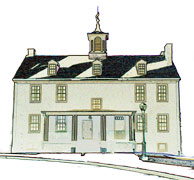




 | | | ||
 | | |||
 | | | | |
 | | |||
 | | |||
| MEDICINE Dr. Robert J. Dodd built a mansion in 1850 on Old Gulph Road in Ardmore; Dodd's Lane now leads to the house. His son, Dr. Robert J. Dodd, Jr., lived there after his father's death in 1876. Dr. Joseph Anderson lived in Ardmore at Old Lancaster and Mill Creek Roads. Dr. Gorham Parsons Sargent, of Bryn Mawr, was especially interested in maternity cases and was physician in charge of the Good Shepherd Hospital for Children, founded by the Episcopal Church of the Good Shepherd in 1873. In 1893 a group of socially prominent women established the Bryn Mawr Hospital. The new building, designed by Frank Furness, was ultra-modern with an elevator and electric lights. It was the brain child of Ardmore's Dr. George S. Gerhard, nephew of a famous Philadelphia physician, William Wood Gerhard. George S. Gerhard maintained stables in Overbrook, Ardmore, and Devon where he changed horses as he drove on his house call route. When the Bryn Mawr Hospital opened, he was assisted by Dr. Robert C. Gamble who served as president of the medical staff until 1939. A medical laboratory was installed in 1905. Dr. Max Strumia, the director of laboratories from 1932 until after World War II, received honors and worldwide fame for his research on the use of blood plasma in the treatment of shock. The school of nursing also opened in 1905. Nurses worked seventy hours a week and discipline was severe. Not until 1933 was the work-week reduced to sixty-four hours. At the request of the American Red Cross during World War I, the hospital increased the size of the nursing school classes. Eighteen Bryn Mawr nurses were in military service in World War I. The hospital's first patient, a man with acute appendicitis, wisely refused surgery but submitted to "freezing" his appendix and survived to age ninety-five. Most of the patients were servants of Main Line families. People went to hospitals for care only in dire extremity. The first blood transfusion at Bryn Mawr Hospital took place in 1918. Four of nine patients receiving transfusions that year died; until blood typing was perfected, transfusion was a risky procedure. An obstetrical department opened in 1919. Most of the doctors along the Main Line, among them Drs. Chrystie, Council, Branson, Alison, and William C. Powell, a homeopath, had autos by 1902 or 1903. They were mostly Autocars, although Dr. Gerhard had an impressive Maxwell and Rosemont's Dr. Branson made house calls in an immense Stanley Steamer. In 1907 the hospital replaced its horse drawn ambulance with an Autocar that had inflatable tires on wooden wheels, limelight lamps flanking the driver's seat, a big spotlight in front, and a rubber horn. Its top speed was thirty miles an hour. In 1943 T. Truxton Hare became managing director of Bryn Mawr Hospital succeeding W. W. Bodine as president of the Board of Trustees after the war ended. Other outstanding benefactors of the hospital included Rudulph Ellis, Samuel M. Vauclain, George R. Packard, Robert E. Strawbridge, and C. Willing Hare. In 1980 Carl I. Berquist was president of administration, and Edward Starr III chairman of the board. From 20 beds, the Bryn Mawr Hospital had grown, by 1980, to 397 beds and 28 bassinets, and employed 1,315 people and a medical staff of 310 doctors to care for the 15,347 patients admitted that year. The Lankenau Hospital, formerly the German Hospital of Philadelphia, where it was chartered in1860, moved into Lower Merion in 1953. Designed by Vincent Kling and built on Lancaster Avenue near City Line, the hospital was named for John D. Lankenau, who, with his wife, the former Mary Jane Drexel, was an early benefactor. Dr. John B. Deaver, the surgeon who ruled supreme in the amphitheater from 1880 to 1931, was followed by his son, J. Montgomery Deaver. Some of the nurses were Lutheran deaconesses, members of a German religious nursing order who provided superior nursing care. Since 1966 Lankenau has been affiliated with Jefferson Medical College. Teaching programs have been broadened, dozens of new medical services have been added, and the original building has been enlarged and renovated. In 1980 the hospital admitted 15,955 patients, employed 1,639 people, and had 448 beds and 41 bassinets. The controversial Dr. Albert C. Barnes, who was born in Kensington, Philadelphia, made a fortune patenting an antiseptic medicine, Argyrol, for which he lost his medical license. He lived in Merion and left his priceless modem art collection to the community along with his colorful reputation. Samuel Booth Sturgis, the patriarch of township doctors, was born in 1891 in West Manayunk within fifteen miles of the spot where his Swedish ancestor, Sven Shute, landed on Tinicum Island in 1643. Dr. Sturgis has practiced on the Main Line since 1918. One of his classmates at Lower Merion High School was Monroe Hinson Tunnell, a black doctor who practiced in Bryn Mawr. Dr. Tunnell was a graduate of Jefferson, where he won the graduating class gold medal in gynecology. Dr. Sturgis also remembers Drs. Clifford and Herbert Arnold, who practiced in Ardmore. |